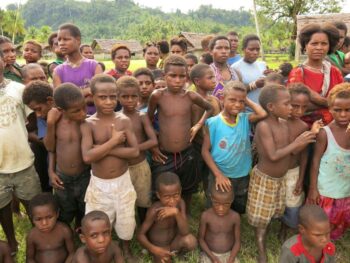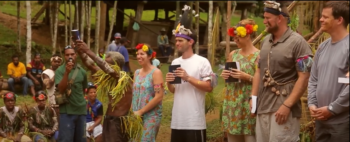
By Michael Ashcraft –
After years of learning the language, developing an alphabet, teaching literacy, missionary Brooks Buser and team gave the YembiYembi tribe in Papua New Guinea copies of the Bible five years ago.
“It has been a long time, almost 2,000 years, that we the YembiYembi church have waited for this translation of the Bible into our own language,” says a tribe leader on a Radius International video.
Waving palm-like branches (or feathers) and dancing, about 100 tribe members received the printed and bound Bibles – the labor of nine years delivered by small prop plane – with fanfare, preaching and jubilation.

The YembiYembi live in the Lower-Sepik Swamp of remote Papua New Guinea. With an estimated 5,000 members, the tribe with only three villages is so small that it’s not even in Wikipedia. You can reach it by plane or paddling 270 miles upriver. Their language is Bises.
Once the translation was finished, Radius International missionaries left trained local pastors to take charge of the church. From the video, it appears the majority of the tribe accepted Jesus, but a “vocal minority” remains in opposition to abandoning the customs of its elders.
“The Bible is important,” preached Brooks, 37, in Bises, which the video translates into English through subtitles. “But what’s more important is what you do with it as the church, the body of Christ. The Bible is here to help believers grow. I will visit you, but this Bible will guide you now.”
Brooks was a missionary child who grew up in Papua New Guinea evangelizing another remote tribe in the lush jungle. “The seeds of missions were planted in my mind,” says the man who counted San Diego as his American hometown.

As a child, Brooks spent half his time in the mud of the jungle with native friends and half his time at the missionary school, playing basketball and learning a traditional Western education.
“I remember getting on the plane here at 9 o’clock in the morning and flying to school and playing a basketball tournament that night in the gymnasium, looking down at my leg and I still have a little bit of mud on my leg from the tribe,” he remembers. “It wasn’t a normal upbringing. The blending of these two worlds was a unique way to grow up.”
Armed with an accounting degree from San Diego Christian College, he married Nina and pursued a career counting numbers. He became finance manager and even traveled to Paris, “on track for the American Dream,” he says.
But on a visit to his parents in Papua New Guinea, the newly married couple’s hearts were stirred. “She got to see where I grew up,” he explains. “God began to lay on our hearts the nation. We felt an incredible level of comfort leaving the American Dream behind and coming back here as missionaries.”
In 2001 with their newborn Beau, they began training with New Tribes Mission where they learned how to set up solar panels and build airfields. “There’s no power, there’s no stores” in these isolated areas where they reach tribes, Brooks says.

“During the class there was a lot of things that brought us out of our comfort zone,” Nina says. “There was a class on animal butchering which was not my favorite.”
They learned phonetics and grammar to learn and codify the language. They launched into Third World life in Papua New Guinea in 2003. The Busers began surveying and exploring land to find an ideal unreached tribe to work with. Tribes actually write letters requesting missionaries be sent, probably because they have heard of the benefits of civilization and medicine that missionaries bring.
Because the airstrip was flooded at their first choice on the day of their launching into the mission field, the Busers went to their second choice, the YembiYembi. They flew to the nearest airfield, traveled by canoe and then hiked – a five-hour journey – to arrive.
The tribe was so excited and received the missionaries with a welcoming ceremony. “In 2004, we started building our houses,” he says. They had a team of fellow linguist missionaries. They had batteries for their laptops and a two-way radio to communicate with their base.

They began building an airstrip with the help of 1,000 Yembis, removing stumps with power tools. After days of intense labor, the mission group sent a barge with a tractor to finish clearing the field.
“That gave us our lifeline back to base,” Brooks says.
Simultaneously, they learned about their language and culture, hunting in the jungle late at night.
“The callouses on our feet got a lot thicker,” he says. “We learned how to throw a spear and hunt pigs, basically live like a Yembi in their environment.”

Missionaries are routinely criticized by secular intellectuals for altering native people’s customs and “Westernizing” them. The Yembi were animists.
But Brooks wanted to help the Yembi overcome superstitions that were “handicapping” them, he says. For example, pregnant women are prohibited certain nutritional foods, and men fear to hunt during a mourning period because “the spirit of the dead person might come after them at night.”
Once they developed a written phonetic language and taught people to read, the missionary team embarked on teaching the Bible chronologically from Adam to Christ in 2008. They used drama and late-night teaching sessions. By April, they came to the story of Christ.
When they taught about the crucifixion, death, burial and resurrection of Jesus, they saw a rainstorm building and feared that half their audience, outside the “teaching house” would disappear.
“When the rainstorm hit, it split. Half of the rain was over here and half was over there,” Brooks remembers. “In the actual teaching house, nobody got wet. Even the Yembi were looking around like, ‘This is kind of weird.’ It was a neat thing that God did.

“About 50-60 people understood what Christ had done for them on that day, and the Yembian church was born.”
Unbelievers raised “a lot of animosity,” Nina says. “Brooks’ life got threatened a few times. Our house was threatened to be burned down a few times. A few spears got thrown. But the word went forth, and it drew the believers together who were believers at that time.”
The persecution brought “a purifying effect,” Brooks says. People who got baptized or took communion were threatened. “You were either in or you were out,” he says. “In the end it was the best thing because it forced them to choose which side they were going to be on.”
They started translating with Acts, Romans, Ephesians and 1 Corinthians, getting up at 4:30 a.m. to translate. Halfway through the New Testament, they published a provision spiral bound copy, received with excitement by the Yembi.
“We had a guy who said he read through it in about two weeks,” Brooks says.
The thrill impelled them on to translate the entire Bible.
They trained teachers to impart literacy and teach the Bible.
“We wanted to leave a church that could stand on its own,” Brooks says. “It wasn’t just translation. It wasn’t about literacy. It wasn’t about medical. It wasn’t about airstrips. It was about seeing a church left behind.”
It took nine years to complete the translation and compile and print a Bible
“We don’t go in there to live there forever and ever,” Nina says. “We go in to work ourselves out of a job.”
If you want to know more about a personal relationship with God, go here
About the writer of this article: Pastor Michael Ashcraft is also a financial professional in California and other states.
Most of the photos are from Jeff Hamann from the Radius International website.




[…] But Brooks… Read the rest: YembiYembi tribe in Papua New Guinea […]
Comments are closed.